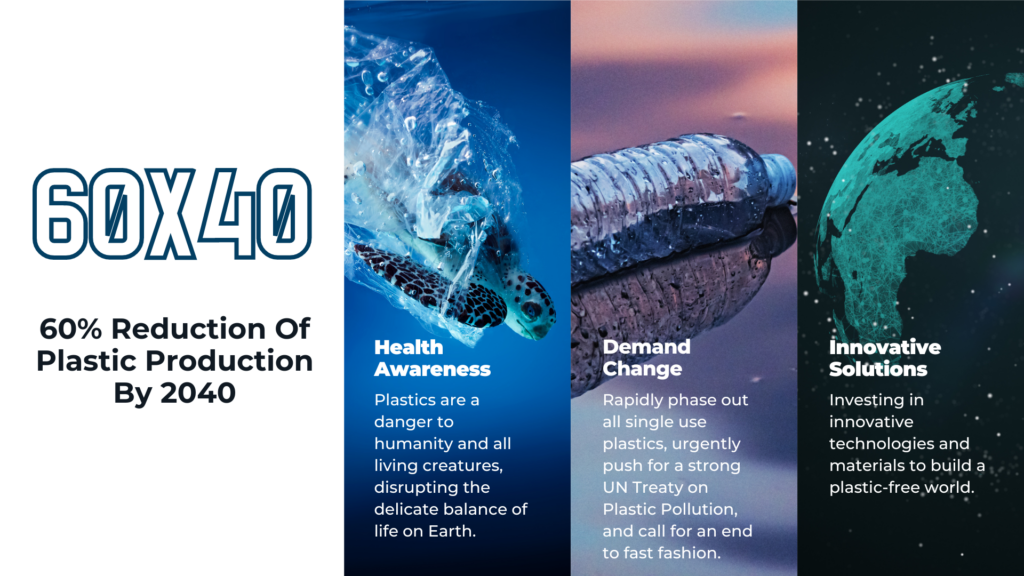Planet vs. Plastics Global Theme for Earth Day 2024

Planet vs. Plastics unites students, parents, businesses, governments, churches, unions, individuals, and NGOs in an unwavering commitment to call for the end of plastics for the sake of human and planetary health, demanding a 60% reduction in the production of plastics by 2040 and an ultimate goal of building a plastic-free future for generations to come.
To achieve a 60% reduction by 2040, EARTHDAY.ORG’s goals are: (1) promoting widespread public awareness of the damage done by plastic to human, animal, and all biodiversity’s health and demanding more research be conducted on its health implications, including the release of any and all information regarding its effects to the public; (2) rapidly phasing out all single use plastics by 2030 and achieving this phase out commitment in the United Nations Treaty on Plastic Pollution in 2024; (3) demanding policies ending the scourge of fast fashion and the vast amount of plastic it produces and uses; and (4) investing in innovative technologies and materials to build a plastic-free world.
“The Planet vs. Plastics campaign is a call to arms, a demand that we act now to end the scourge of plastics and safeguard the health of every living being upon our planet.”
Kathleen Rogers
President
“The word environment means what surrounds you. In the case of plastics we have become the product itself – it flows through our blood stream, adheres to our internal organs, and carries with it heavy metals known to cause cancer and disease. Now this once-thought amazing and useful product has become something else, and our health and that of all other living creatures hangs in the balance,” said Kathleen Rogers, President of EARTHDAY.ORG. “The Planet vs. Plastics campaign is a call to arms, a demand that we act now to end the scourge of plastics and safeguard the health of every living being upon our planet.”
Plastics extend beyond an imminent environmental issue; they present a grave threat to human health as alarming as climate change. As plastics break down into microplastics, they release toxic chemicals into our food and water sources and circulate through the air we breathe. Plastic production now has grown to more than 380 million tons per year. More plastic has been produced in the last ten years than in the entire 20th century, and the industry plans to grow explosively for the indefinite future.
“All this plastic was produced by a petrochemical industry with an abysmal record of toxic emissions, spills, and explosions,” said Denis Hayes, Chair Emeritus of EARTHDAY.ORG. “Plastics are produced in polluting facilities that somehow seem to always be located in the poorest neighborhoods. Some plastics are lethal when combusted; other plastics transmit hormone-disrupting chemicals; and all plastics can starve birds and suffocate sea life. At every stage of their life cycles, from the oil well to the town dump, plastics are a dangerous blight.”
More than 500 billion plastic bags—one million bags per minute—were produced worldwide last year. Many plastic bags have a working life of a few minutes, followed by an afterlife of centuries. Even after plastics disintegrate, they remain as microplastics, minute particles permeating every niche of life on the planet.
100 billion plastic beverage containers were sold last year in the United States. That’s more than 300 bottles per inhabitant. A few of them will be converted into park benches; none of them will be made into new plastic bottles and 95% of all plastics in the US won’t be recycled at all. Even the 5% of plastics being recycled are “downcycling” to inferior products or shipped to poorer countries for “recycling”, leaving the demand for virgin plastic undiminished.
People seldom think of water when they think of plastics. But making a plastic water bottle requires six times as much water as the bottle itself contains.
EARTHDAY.ORG demands the International Negotiating Committee on Plastic Pollution (INC) mandate the end of production of single-use plastic by 2030 in the Global Plastics Treaty. Moreover, it demands the treaty be implemented using the precautionary principle and the polluter pays doctrine.
“All this plastic was produced by a petrochemical industry with an abysmal record of toxic emissions, spills, and explosions.”
Denis Hayes
Chair Emeritus
The fast fashion industry annually produces over 100 billion garments. Overproduction and overconsumption have transformed the industry, leading to the disposability of fashion. People now buy 60% more clothing than 15 years ago, but each item is kept for only half as long.
Approximately 85% of garments end up in landfills or incinerators, with only 1% being recycled. Nearly 70% of clothing is made from crude oil, resulting in the release of dangerous microfibers when washed and continued contribution to long-term pollution in landfills.
Social injustice and fashion are directly intertwined, with exploitative working conditions, low wages, and widespread child labor. For far too long, the industry has relied on a fractured supply chain and an almost total lack of governmental regulation.
To learn more about Planet vs. Plastics and join the movement for a plastic-free future, please visit: Earth Day 2024. To educate yourself on the impacts of plastic on human health, check out the Plastics Health Research Module and EARTHDAY.ORG’s Earth Hub for all fact sheets, toolkits, press releases, and articles.